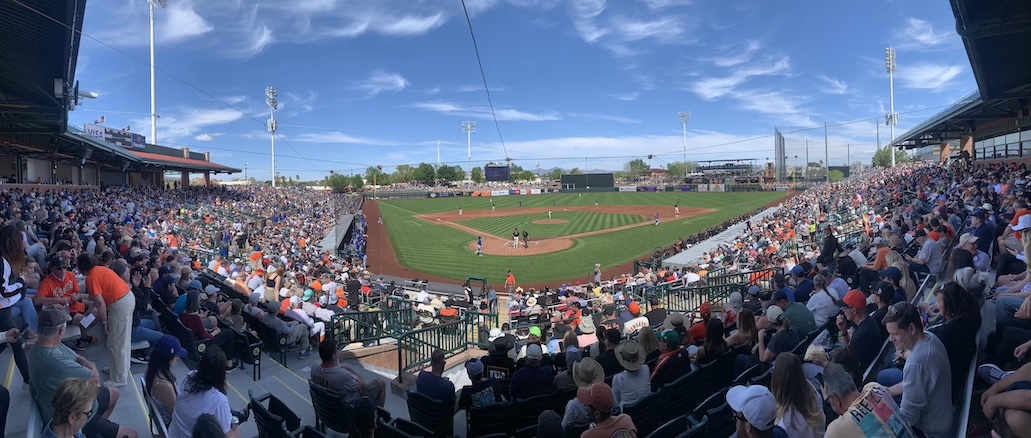posted: April 1, 2023
tl;dr: Coming soon to an MLB stadium near you: the best sports innovation since basketball’s shot clock...
In Spring 2023 our esteemed leaders, in their infinite wisdom, delivered unto us the first normal spring training since 2019. The reaction to the COVID-19 endemic wreaked havoc with the spring version of the nation’s pastime:
Thankfully, the fans and businesses that survived these lean years were able to enjoy, albeit with noticeably higher prices, a full Spring Training schedule of games. I made it to three Cactus League games:

The centerfield pitch clock at Camelback Ranch
As teams disperse to their regular season stadiums, and fans watch games in person or on television, more will experience the sensation I’ve had this spring: the MLB game is much faster paced, thanks to the pitch clock. Gone are the days of watching David Ortiz adjust both batting gloves after every single pitch, even when he had not swung, and watching agonizingly slow pitchers pace around the mound and debate with their catchers which pitch to throw next. The pitch clock rule is simple: it starts when the pitcher receives the ball from either the catcher or the umpire. Fifteen seconds go on the clock if no runners are on base; if there are runners, it’s twenty seconds. The batter must be “alert to the pitcher” (ready to hit) at the eight-second mark, else it’s an automatic strike. The pitcher must start his windup before the clock expires, else it’s an automatic ball. No doubt there will be arguments about how those two milestones are applied by the umpire, but the rule is straightforward.
The game moves forward much more rapidly. Sometimes the three outs of a half-inning are recorded in under two minutes. The longest of the three games I attended, the first one, took only three hours and three minutes (3:03), even though seventeen runs were scored and there were plenty of substitutions, as is typical in an early Spring Training game. The other two games took only 2:28 and 2:19. The action in the game gets compressed into a shorter time period. I think nearly everyone, from casual baseball fans to the most committed, is going to enjoy this change. Personally, it means I will be able to make it to the end of many more games, instead of falling asleep or having to leave. The only perverse effect it has is that there is still the same time period between innings, so the space between the commercial breaks of a game broadcast on TV lessens, meaning the percentage of commercial time of the broadcast is higher.

Scottsdale Stadium, the Spring Training home of the San Francisco Giants
In effect every MLB game is now like watching former White Sox pitcher Mark Buehrle, the master of fast-paced pitching, throw every single pitch. Buehrle was beloved by White Sox fans for multiple reasons, pace of play being one of them. MLB has finally come up with a viable way of implementing the last suggestion in my Speeding up baseball games post from 2021.
MLB’s pitch clock serves the same purpose as basketball’s shot clock. Pre-shot clock basketball predates me, but I do know that the shot clock was implemented to speed up the game and create more action for the enjoyment of fans. Prior to the shot clock, basketball teams could play a possession game, dribbling and passing the ball for long stretches of time before finally taking a high-percentage shot, to keep the overall score down and hence also the score differential. But it was boring to watch. The shot clock and the three point lines made a huge impact on basketball, and I predict the pitch clock will do the same for baseball.
Related post: Speeding up baseball games